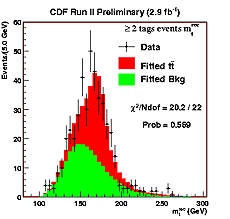Seeing jets from the top

Distribution of the reconstructed top quark mass for signal events with at least two b-quark jets.
Even 14 years after its discovery, the top quark is largely terra incognita. Its heavy mass was the most surprising property at the time of its discovery, and is still a captivating topic. Nowadays, the precise knowledge of the top quark mass can be used to constrain the mass of another theorized special particle, the Higgs boson, but also it suggests a special role of the top quark in the particle family.
Most of the Tevatron collisions produce quarks or gluons, which appear in the detector as sprays of particles called jets. Top quarks on the other hand are produced only once in 10 billion collisions. They appear mostly in pairs, each decaying very quickly to a b quark and a W boson. B quarks produce long-lived particles whose decay products can be identified, allowing b jets to be "tagged." W bosons can decay into leptons, which are uncommon at a hadron collider such as the Tevatron. This helps to improve purity by removing background events that do not contain leptons.
Still, the W bosons usually decay into two quarks each; giving four jets in addition to the ones from b quarks. A CDF group used this signature, only based on jets, to isolate a sample of top quark events. After requiring b-tagged jets, they further cleaned up the event sample by exploiting the differences between the jets that originated from quarks and the jets that originated from gluons. Gluons are typically created in uninteresting collisions. Using this novel approach, CDF scientists achieved the highest purity ever obtained in this sample, and they were able to measure the top mass with the unprecedented precision for this channel of 1.5 percent.
This measurement will help increase the overall precision on the knowledge of the top quark mass. Also, with a sample much cleaner than in the past, many additional studies using top quarks are now possible, and scientists hope to be surprised by the outcomes.
-- edited by Craig Group

From left: Luca Brigliadori, Bologna University; Andrea Castro, Bologna University; and
Fabrizio Margaroli, Purdue University.
|